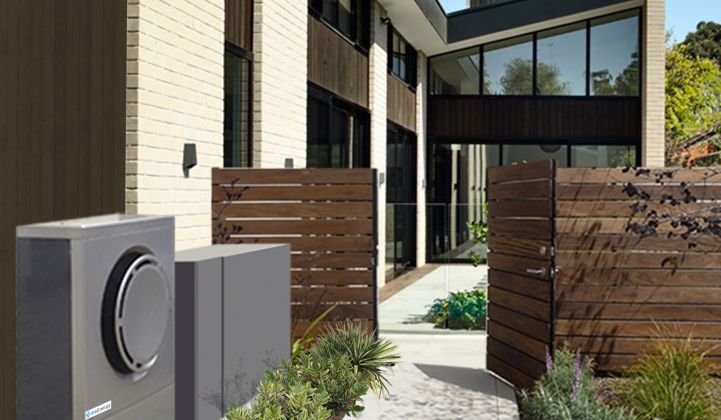Soon, homeowners will be able to access a form of storage thus far reserved for businesses and large buildings. A form of storage that uses ice.
Thermal storage, which converts electricity to heat or cold for later use, has penciled out in select locations so far. Santa Barbara-based Ice Energy sells systems to commercial customers in California, Calmac has made a name for itself serving skyscrapers in New York City and similarly grand structures, and Viking Cold Solutions and Axiom Exergy offer thermal storage for the cold supply chain. Some hot storage options exist for the household market, but no firm had attempted that for ice storage until recently.
The Ice Cub -- the smaller offspring of the C&I-scale Ice Bear -- could blow open a whole new market for residential thermal storage.
Ice Energy had been looking into residential applications for about five years, said CEO Mike Hopkins, who learned how to work with ice growing up in Calgary, Canada. Part of the impetus came from utilities asking for help dealing with residential energy demand. The Ice Bear systems connect to existing AC units, chilling the air that pumps through the existing compressor, but that was getting too complicated at a smaller scale.
"The breakthrough we got to was when we figured out we could do this all in one: Don't add to the air conditioner, just replace the conventional home air conditioner," Hopkins said. "Make one system that's both a cooling system and an ice storage system, that can sometimes be cooled conventionally and sometimes cooled just with ice."
The Ice Cub his team came up with is sized like a 2.5-ton AC unit, the kind that serves small to medium-sized households. This AC has a special power, though: in between air conditioning cycles or when it's not in use, it freezes water in an insulated tank. It can fill the tank with ice in four hours. Then, on command, the system can switch from conventional AC to using the ice to cool the house for at least three hours, during which time no energy is needed to chill the air.
That’s a big deal for anyone who pays time-of-use rates or residential demand charges: The Ice Cub essentially eliminates the electricity demand for cooling, which is the largest single household use for electricity, during three hours of peak demand.
Customers with rooftop solar gain additional value, as they can put excess solar during peak production hours into making ice, which then cuts demand when it’s later used for cooling. In markets where compensation for excess solar generation is dropping, this offers an efficient way to consume more of what the panels produce.
The base price is equivalent to a high-efficiency air conditioner, Hopkins said, but with money from California’s Self-Generation Incentive Program (SGIP), the price comes down to the level of a conventional AC. That, plus California’s huge AC demand, high solar penetration, high electricity prices and green-minded consumers, is leading Ice Energy to focus on the Golden State first.
The target markets are people looking to replace an AC unit, people choosing the AC system for a new house, and developers building new houses. The company estimates that a typical household paying time-of-use rates would save $500 a year on its electricity bill by optimally using the Ice Cub. That makes for a compelling offer: pay the same as you would for a normal AC (assuming the availability of SGIP funding), but get the savings as soon as it's up and running.
The system also comes with a 20-year warranty, and the technology does not degrade over time the way a lithium-ion battery does, said Hopkins.
"We guarantee we'll make the same amount of ice," he said. "It's a tank of water and it freezes; it doesn't freeze less over 20 years."
The company has production facilities in New York state that can make 1,000 Ice Cubs a month, Hopkins said. The company is keeping prices down thanks to an agreement with Danfoss, a Danish heating and cooling parts maker, which agreed to provide certain manufacture-ready components. That provides economies of scale even for the first production run of the product.
The initial sales will be for the benefit of the customers, but Hopkins noted there is “tremendous opportunity” down the road to aggregate the energy storage of these distributed assets and sell it into into available markets.
The value of this should not be understated. Air-conditioning demand drives the growth in peak demand, and the subsequent build-out of peaking gas plants. Those are the most expensive power generation assets, and highly polluting. Widespread deployment of Ice Cubs could play a crucial role in cutting peak demand, which could save ratepayers money on everything from substation upgrades to new gas peakers.
"Thermal storage has historically progressed at a glacial pace, but if investors come in from the cold and warm to the technology, it could allow homeowners to freeze in lower electricity costs as time-of-use rates snowball," said Dan Finn-Foley, senior analyst for energy storage at GTM Research. "Residential customers have traditionally been cool to storage, so it’s unlikely that this will be hailed as the beginning of a thermal storage avalanche, but if markets continue to drift in this direction, then business models could soon begin to crystallize. "



